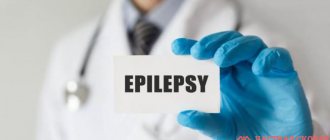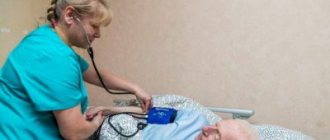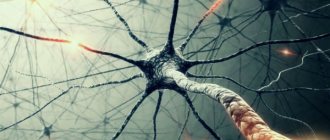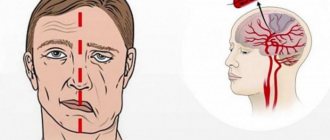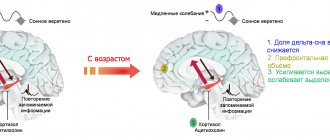Definition of disease. Causes of the disease
Epilepsy is a chronic brain disease characterized by repeated spontaneous seizures (paroxysms) that occur as a result of excessive neuronal discharges.
Clinically, epilepsy is manifested by seizures and changes in consciousness (up to its loss). Epilepsy can be either an independent disease or a symptom of another pathology. According to WHO, approximately every 4-10 people out of 1000 suffer from active epilepsy worldwide - this is one of the most common neurological diseases.
Epilepsy has been known to mankind for a long time - the first known mention of epilepsy came to us from 500-700. BC. Stone slabs were discovered in Babylon that contained a detailed description of the disease, types of attacks, provoking factors, and post-attack symptoms. The ancient Greeks saw epilepsy as a supernatural, divine phenomenon and called it a sacred disease. In 450 BC. Hippocrates was the first to state that the disease has completely natural causes and originates in the brain.
The disease is a serious social problem, as a lack of information about epilepsy contributes to misunderstanding, fear of symptoms among others and discrimination against patients.
The disease manifests itself in the form of short-term involuntary spasms in any part of the body, or spasms affect the entire body. Sometimes attacks are accompanied by loss of consciousness and loss of control over bowel or bladder functions. Seizures can range from minor memory loss and muscle spasms to severe, prolonged convulsions.
People with epilepsy are more likely to suffer bruises and fractures related to seizures. They are also more likely to have anxiety disorders and depression. In addition, patients with epilepsy have an increased risk of premature death from falls, drowning and burns.
Causes of epilepsy
There are many factors that lead to the occurrence of spontaneous bioelectrical activity (neuronal discharges), which lead to repeated epileptic seizures. Causes of epilepsy include structural, genetic, infectious, metabolic, immune and unknown etiological factors, for example:
- some genetic diseases;
- brain damage in the prenatal period and during birth (hypoxia or birth trauma, low birth weight);
- congenital malformations of the brain;
- head injuries;
- stroke;
- infections - meningitis, encephalitis, neurocysticercosis;
- brain tumors.
Some types of epilepsy can be triggered by sleep deprivation, alcohol intake, smoking, stress, hyperventilation, sensory stimuli: flashing lights, temperature changes, loud noises, temperature changes, hormonal fluctuations during the menstrual cycle, abuse of antidepressants, premature withdrawal. from special therapy, if one was prescribed.
It should be understood that the appearance of a single convulsive attack, although it is an alarming symptom, does not always indicate the presence of epilepsy. The doctor has the right to consider this diagnosis if the patient has had two or more attacks.
Drug load in patients with epilepsy
Materials and methods
The study was published in the December issue of the journal Epilepsia. To understand what clinical factors may influence AED load, including disease severity associated with AED drug load, researchers examined data from a large cohort of 1,135 patients treated conservatively as outpatients. A separate analysis was also conducted in a smaller sample of 91 preoperative patients who subsequently underwent surgery for mesial temporal lobe epilepsy. The mean duration of epilepsy was 9.0 years for patients receiving monotherapy, 17 years for patients receiving two AEDs, and 21 years for patients receiving three AEDs. Clinical variables in both study groups included presence of underlying cerebral lesion, age of onset of epilepsy, duration of epilepsy, seizure frequency, seizure type, ictal disturbance of consciousness, and history of convulsive status epilepticus. In the preoperative group, the researchers replaced cerebral lesion pathology with the degree of hippocampal pathology and added a clinical score on the Global Assessment of Epilepsy Severity (GASE) scale. The researchers estimated patients' total AED burden using the number of concurrently prescribed AEDs and the cumulative total drug burden measured by a specific daily dose.
results
- In the outpatient group, 38.8% of patients received two AEDs simultaneously. An additional 25.6% of patients received three AEDs, 8% received four, and 2% received five. In addition, 20.3% of outpatients received AED monotherapy, and 5% received no therapy.
- The majority of patients in the preoperative cohort (56%) received two AEDs in parallel. Another 26.4% received three AEDs, and 17.6% received monotherapy.
- The prevalence of cerebral involvement in the outpatient group was 53.8%, and 42.2% had recurrent generalized or focal or bilateral tonic-clonic seizures.
- About 92% of patients had ictal disturbance of consciousness.
- The average monthly attack frequency was 12.8.
- Markers of disease severity had a significant but weak correlation with AED burden (r ≤ 0.15).
- Ictal disturbance did not correlate with AED load.
- In descending order, age at onset of epilepsy (r = -0.15), presence of primary lesion (r = 0.13), and frequency of seizures per month (r = 0.13) had the strongest correlation with the number of AEDs.
- Overall, clinical markers explained 6% of the variance in the number of AEDs taken simultaneously and 10% of the variance in the assigned daily dose.
- Duration of epilepsy explained 5% to 8% of the variation in AED load.
- All patients in the preoperative cohort had structural brain damage and ictal disturbance of consciousness. A history of convulsive status epilepticus was associated with higher AED dosage (r = 0.35). None of the other clinical factors were associated with drug load. The researchers found no significant correlation between the GASE score and drug load.
Conclusion
Results from a large, single-center, cross-sectional study found only a minor association between measures of total drug burden and markers of disease severity. High doses of medications do not leave room for further escalation of medications during exacerbation of epilepsy. The individual drug load while taking AEDs in most patients is determined by additional factors. Attack frequency determines the daily dose of AEDs and explains the largest difference in the number of AEDs taken. The researchers hope to encourage neurologists to avoid and critically re-evaluate high AED loads in patients with epilepsy. Clinicians' highest priority for patients with newly diagnosed epilepsy is achieving complete seizure control.
Source:
medscape.com/viewarticle/943383
Symptoms of epilepsy
The main clinical manifestation of epilepsy is epileptic paroxysms: seizures that occur due to pathological (too intense or too slow) electrical discharge in the brain. The attack is usually short-lived, stereotyped (has characteristic repetitive features) and is manifested by disturbances in behavior, emotions, motor or sensory functions.
Based on duration and possible cause of occurrence, the following are distinguished:
- long-term (status epilepticus);
- random (occurring unexpectedly and without a provoking factor);
- cyclical (occurring at periodic intervals);
- provoked epileptic paroxysms (arising due to the influence of exogenous or endogenous factors or caused by sensory stimulation).
An epileptic attack can occur as a single episode or as a series of attacks, between which the person does not come to his senses and does not fully recover. The attack may be accompanied by convulsions or occur without them.
According to clinical manifestations, generalized and partial (focal) seizures .
- The most common type of generalized seizure is a tonic-clonic (convulsive) seizure . Against the background of complete health, a person loses consciousness, falls, the body arches - a symmetrical tonic tension of the body occurs, there may be a bite of the tongue, a short-term holding of breath, then the muscles begin to twitch (clonic convulsions), sometimes there is involuntary urination or defecation. The duration of the attack is up to 5 minutes.
- Clonic seizures . They are rare and are manifested by muscle spasms - repeated twitching.
- Tonic seizures . They manifest themselves as sudden paroxysmal muscle tension, overexertion makes breathing difficult, the patient rolls his eyes and falls (if the attack caught him in a standing position). Injuries may occur if you fall.
- Atonic (astatic) seizures are characterized by non-convulsive loss of consciousness with a sudden loss of muscle tone and the same rapid recovery.
- absence seizures are most often detected : the child freezes for a few seconds, but at the same time can make some movements.
- Atypical absence seizures , unlike classic ones, are characterized by a gradual onset and end. Most often they are accompanied by head nods, body bends, and cascading falls. Muscle twitching is usually minimal.
- Myoclonus is manifested by short-term irregular twitching of a group of muscles.
Partial seizures are also called focal or localized seizures. Seizures can occur differently depending on what part of the brain the disorder affects and how far it spreads. Symptoms include loss of orientation, disturbances in movement, sensation (including vision, hearing, and taste), mood, or other cognitive functions.
Epilepsy
Simple partial seizures often begin with an aura. Depending on the irritation of the brain area, there are several main types of aura - vegetative, motor, mental, speech and sensory.The most common symptoms: nausea, discomfort in the stomach, weakness, dizziness, headache, transient speech disturbances (aphasia), numbness of the lips, tongue, hands, a feeling of constriction in the throat, chest pain or breathing difficulties such as lack of air, unpleasant sensations in the mouth, a state of drowsiness, an unusual perception of everything around, “feelings that are difficult to describe,” a feeling of “never seen” and “already seen,” auditory paroxysms (ringing, tinnitus), olfactory paroxysms, a feeling of “heat” , “lump” in the throat, etc. The presence of an aura in a patient often makes it possible to clarify the location of the epileptogenic focus.
Complex partial seizures are often accompanied by undirected and inappropriate movements.
In some cases, with partial seizures, pathological activity, initially focal, spreads throughout the brain - a secondary generalized seizure develops. A secondary generalized attack can begin suddenly with the appearance of an aura, which in the same patient often has a stereotypical character. The aura lasts for several seconds. The man loses consciousness and falls. The fall is accompanied by a kind of loud cry caused by a spasm of the glottis and convulsive contraction of the chest muscles. Tonic convulsions immediately appear - the torso and limbs are stretched in a state of tension, the head is thrown back and turned to the side, breathing is held, the veins in the neck swell, the face becomes deathly pale with gradually increasing cyanosis, the jaws are convulsively clenched. The tonic phase of the attack lasts 15-20 s.
Then clonic convulsions appear in the form of contractions of the muscles of the limbs, neck, and torso. During the clonic phase of an attack lasting up to 2-3 minutes, breathing is often hoarse and noisy. The mouth produces foam, often tinged with blood, due to biting the tongue or cheek. The frequency of clonic convulsions gradually decreases, and at the end of them, general muscle relaxation occurs. During this period, the person does not react even to the strongest stimuli, the pupils are dilated, and there is no reaction to light.
In primary generalized seizures, both hemispheres of the brain are involved in the pathological process. The most common types of generalized seizures are tonic-clonic and absence seizures. The latter are observed in children and are characterized by a sudden and short-term cessation of play, conversation, freezing, and lack of response to calls. After 10 seconds, he continues the interrupted activity no more, does not realize and remembers nothing about the attack. The frequency of absence seizures sometimes reaches several dozen per day.
Complications of epilepsy
The following complications are possible with epilepsy:
- status epilepticus of generalized seizures;
- injuries (bruises, fractures);
- increased intracranial pressure: accompanied by bursting headaches, nausea and vomiting, and sometimes confusion;
- cerebral edema (accumulation of fluid inside nerve cells and in the intercellular space): characterized by an increase in neurological symptoms, possible depression of consciousness up to coma;
- ischemic and hemorrhagic stroke: with epilepsy, a violation of the central regulation of vascular tone occurs, blood pressure can sharply increase, which, with predisposing factors (atherosclerosis, aneurysms), leads to depletion of blood flow and ischemic stroke or rupture of the vessel wall and hemorrhage;
- thrombosis of intracranial veins: develops against the background of stagnation of venous blood when vascular regulation is disturbed during an epileptic seizure; in acute inflammation it manifests itself as an ischemic stroke;
- aspiration pneumonia;
- PE (pulmonary embolism) is accompanied by a feeling of lack of air, a sharp increase in breathing, blood pressure drops to low numbers, and death is possible;
- pulmonary edema due to status epilepticus;
- cardiogenic shock;
- renal failure due to cardiogenic shock.
Diagnosis of epilepsy
Diagnostic capabilities are currently very wide; they make it possible to accurately determine whether a patient suffers from epilepsy or whether an attack is a consequence of another disorder. For this, first of all, instrumental examinations , which are crucial in diagnosing and determining the type of seizure.
EEG (electroencephalography) is the main diagnostic method. Patients with epilepsy show changes in their brain wave patterns even when they are not experiencing seizures.
CT and MRI of the brain. The fundamental methods for diagnosing epilepsy are visual diagnostic methods - computed tomography and magnetic resonance imaging. They make it possible to identify the patient’s organic substrate (tumors, cysts, vascular malformations or aneurysms), evaluate its function and structure, and sometimes identify foci of abnormal electrical activity that occur in epilepsy.
An anamnesis of the disease is very important , which allows, based on questioning the patient, to find out the details of the onset and development of the disease, its duration, nature of the course, and the presence of a hereditary predisposition to epilepsy. It is extremely important to describe the paroxysms themselves, their frequency, description, and the presence of factors contributing to the occurrence of attacks. Such questioning allows the doctor to determine the type of seizure and also suggest which area of the brain may be affected.
It should be understood that the appearance of a single convulsive attack, although it is an alarming symptom, does not always indicate the presence of epilepsy. The doctor has the right to consider this diagnosis if the patient has had two or more attacks.
Epilepsy and television, computer technology
Epilepsy is known to be a brain disease that causes repeated, unprovoked seizures. An exception to this rule are reflex forms of epilepsy that arise as a result of provoking factors. The most common type of reflex form is photosensitive epilepsy. This disease usually debuts in adolescence, with a predominance in girls. In approximately 50% of patients in this group, seizures occur only in response to rhythmic light stimulation. The most dangerous frequency for humans is 15-20 flashes per second.
Provoking factors can be any type of intermittent rhythmic light stimulation in everyday life: watching television (especially light shows and “shooter” cartoons); computer monitor screen (mainly video games); color music at discos; cycling along linearly planted trees; observing the flickering of telegraph poles or a light source through a window in a vehicle (especially at night and at high speed); observing the sun's glare on the water; flickering headlights of passing vehicles while driving in a car. These are just the most common factors; in fact, there are many more of them.
A special type of photosensitivity form is television (or computer, which is essentially the same thing) epilepsy, in which seizures are provoked mainly by watching television or playing computer games. Seizures can occur during computer games or when using game consoles. There are even terms such as “computer game epilepsy” and “star wars epilepsy”. Such attacks occur between the ages of 7 and 17 years and are usually provoked by prolonged viewing of television programs with flashing images (for example, cartoons) in a dimly lit room. Seizures more often occur when viewing images in black and white, and when the distance to the TV screen is less than 2 m. Seizures may occur only when approaching the TV screen when switching TV channels. Some patients experience a unique phenomenon of “forced attraction to the television screen.” At the same time, before the onset of attacks, they begin to peer intently at the television screen, which gradually occupies the entire field of vision. There is a feeling of being unable to take your eyes off the TV screen and a violent attraction to it. Patients slowly approach the TV, sometimes coming close, then loss of consciousness and generalized tonic-clonic convulsions occur.
Treatment of patients with photosensitivity epilepsy is extremely difficult. In addition to the use of basic antiepileptic drugs, compliance with a number of regime measures is mandatory. First of all, factors of rhythmic light stimulation in everyday life should be avoided. If this is not possible, then the easiest way to avoid an attack is to cover one eye with your hand. Using polarized sunglasses, preferably blue, can also help. Preventative measures regarding television viewing include:
- Increasing the distance between the patient and the television screen by more than 2 m.
- Use of additional TV screen lighting installed near the TV and sufficient general lighting of the room.
- Prohibition of watching programs if the TV is faulty or the program settings are unclear (flickering images).
- Covering one eye with your hand when you need to move closer to the TV screen or when changing channels.
- The most optimal are modern 100 Hz color TVs with remote control, as well as LCD computer monitors. For patients suffering from all other forms of epilepsy, except photosensitivity, watching television and working on a computer are not contraindicated, and the duration should be determined by general hygienic standards for children of this age.
Epilepsy and lifestyle
It should be remembered that patients with epilepsy are ordinary normal people who are no different from other people, especially in the period between attacks.
Most children (about 90%) with epilepsy can attend regular schools and kindergartens. It is recommended to inform the staff about the child’s illness in order to enable them to act correctly if attacks occur. There is no need to restrict children from additional classes in a foreign language, music, etc. In most cases, attacks occur during a period of passive, relaxed state, drowsiness. At the same time, mental activity helps to reduce epileptic activity. The leading American epileptologist V. Lennox said that “activity is the antagonist of seizures.” Only a small number of children and adolescents (approximately 10%) have additional severe disorders of the nervous system: motor (cerebral palsy) or mental (mental retardation, psychosis). These children should attend kindergartens and schools with an individual approach and adapted programs. The most severe patients should be trained in special educational centers at home
In general, we can say that children suffering from epilepsy should try to lead a normal lifestyle. It should be taken into account that parental overprotection leads to the isolation of children in society and their poor social adaptation. Children should definitely play sports, as it has been found that active physical activity has a positive effect on the course of epilepsy. Playing sports has a beneficial effect on self-esteem and reduces the level of isolation of children from society. As with people without epilepsy, the healthiest option is regular exercise (exercise). A child with epilepsy should be included in all types of school activities, except for potentially dangerous types of physical education (for example, swimming or participation in certain competitions). When choosing a sport, it is necessary, in addition to personal preference, to also be guided by the fact that the risk of acquiring various injuries is minimal. Each sport contains certain dangers that should be analyzed jointly by the doctor and the patient's family. Tennis, badminton, and some team sports are optimal. Swimming is contraindicated due to the risk of an attack in water.
If you have uncontrolled seizures with impaired consciousness, you must follow simple safety rules, the purpose of which is to minimize the likelihood of injury during an attack: do not be at a height, at the edge of a platform, or near bodies of water. When riding a bicycle, the child must wear a helmet, and rides must take place on roads without cars (dirt roads outside the city). In photosensitive forms of epilepsy, rhythmic flickering of light should be avoided: watching television, computer games, ripples on the surface of reservoirs, flickering headlights of passing vehicles, etc. In all other forms of epilepsy, watching television and working on a computer is possible subject to generally accepted hygienic standards.
For patients suffering from epilepsy, activities related to driving a car, as well as service in the police, fire departments, and guarding important facilities are contraindicated. Working with moving machinery, chemicals, or near water bodies may pose a potential danger to patients. With a shift work schedule, the patient must have the opportunity to get adequate sleep and take medications in accordance with the doctor’s prescriptions. Lack of sleep is especially dangerous for children and teenagers who have seizures immediately after waking up.
In general, a patient's ability to perform activities is influenced by the type of epilepsy, the nature of the seizures, the severity of the disease, the presence of concomitant physical or intellectual impairments, and the degree to which seizures are controlled by antiepileptic drugs.
Recommendations
Recommendations that can help you cope with daily problems and make your life more comfortable.
Believe me, the tips given here can be useful even for people who do not have epileptic seizures. Use them according to the type of seizure or problem you are having.
In bathroom:
- Doors must open outwards, do not lock them (place an occupied sign on the door).
- It is safer to take a shower rather than a bath.
- Sing while in the shower to let your family know you are okay.
- Wash with warm water (avoid too hot water).
- Every time, check whether the drainage and ventilation systems in the bathroom work.
- Patients suffering from frequent epileptic seizures should take additional safety measures while taking a bath (special surfaces, chairs with belts, etc.).
- Do not use electrical appliances (hair dryer, electric lift) in the bathroom or near water.
In the kitchen:
- If possible, cook in the presence of other members of your family.
- Use plastic plates, mugs and glasses.
- Wear rubber gloves when using a knife or when washing dishes.
- Avoid frequent use of sharp knives (if possible, use already cut or prepared foods).
- Use the microwave whenever possible.
At work:
- Inform your colleagues about the possibility of an epileptic seizure and tell them how they can help you (show them how to put you on the pillow, who to call, etc.).
- Avoid stressful and overtime work.
- Wear protective clothing depending on the type of seizure you have and the work you do.
- Keep spare clothes in your office so you can change if necessary.
At home:
- Cover the floor and furniture with soft materials.
- Cover furniture with sharp edges or buy furniture with rounded edges.
- Place protection around open flames, heaters and radiators.
- Avoid smoking and lighting fires when you are alone.
- Do not carry lighted candles, hot dishes or food.
- Avoid heaters that may tip over.
- Use irons and other electrical appliances with care, especially those with a safety circuit breaker.
- Try not to climb on chairs or ladders, especially if there is no one at home except you.
How to behave if your loved one has a seizure?
Most epileptic seizures are limited in time and stop spontaneously after 2-5 minutes without any special treatment.
When an attack occurs for the first time, in all cases it is necessary to urgently consult a neurologist or epileptologist.
Help for a patient with epilepsy depends on the type of attack and its duration. Patients suffering from generalized tonic-clonic seizures often need help. While most people with “minor” seizures (absences) do not need any special intervention. It is important to know the situations in which it is necessary to resort to qualified medical assistance. These may be the following cases:
- an epileptic attack occurred for the first time in life;
- there are doubts that this is an epileptic attack;
- the duration of the attack is more than 5 minutes;
- the patient has respiratory dysfunction;
- regaining consciousness after an attack is too slow;
- the next attack occurred immediately after the previous one (serial attacks);
- an epileptic attack occurred in the water;
- the attack occurred in a pregnant woman;
- The patient was injured during an epileptic attack.
Situations in which immediate medical attention is not necessary:
- if the epileptic attack lasts no more than 5 minutes;
- if the patient regains consciousness and a new attack does not begin;
- if the patient did not injure himself during an epileptic attack.
It is necessary to be able to provide first aid in the event of a generalized tonic-clonic seizure.
The following activities are recommended:
- Remove all objects located in the immediate vicinity of the patient that could harm him during an epileptic attack (iron, glass, etc.).
- Place a soft, flat object (pillow, bag, package) under your head.
- Unbutton your clothes or untie your tie, or loosen your waist belt.
- Until the convulsions stop, move the person to a lateral position (fix the legs straight and the arms lying along the body).
- Do not put any objects in the mouth (spatula, spoon, etc.), and do not attempt to open the patient’s jaws.
- Do not put any liquid into the mouth until the patient has fully regained consciousness.
- It is not recommended to restrain patients during an epileptic attack.
- If the attack happened to a stranger, look in his things for documents confirming a possible illness or an identification bracelet.
- Record the time of onset of the epileptic seizure to determine its duration.
- Always wait at the scene until the patient regains consciousness.
- If necessary, call emergency medical services.
If an epileptic attack occurs in water, the patient must be held in such a way that his head is constantly on the surface of the water. It is necessary to pull the person out of the water while continuing to support his head on the surface. After you have pulled the patient out of the water, it is necessary to examine him and, in case of airway obstruction, immediately begin resuscitation (mouth-to-mouth artificial respiration in combination with chest compressions). Even though the condition of a person who has an epileptic attack under such circumstances is satisfactory, it is necessary to send him to the nearest medical facility for a thorough examination.
In the event of an epileptic attack in transport, it is necessary to vacate the nearest seats and bring the patient into a lateral position. It is also very important to ensure that he can breathe freely. If the seat is adjustable, then it is moved to a supine position until the end of the attack, and the patient himself turns over to the side position to ensure free breathing. It is recommended to cover nearby hard surfaces with pillows, blankets, clothing or bags to avoid injury during a generalized attack.
Drug treatment of epilepsy
Principles of drug treatment for epilepsy:
- the main drugs for treating the disease are anticonvulsants;
- it is necessary to choose the right dosage and regimen - only a specialist doctor can do this;
- when choosing a drug, you need to take into account the type, frequency and time of occurrence of attacks;
- the absence of convulsive seizures does not mean that recovery has occurred - in no case should you stop taking the drug yourself or take breaks without the knowledge of the doctor;
- the doctor controls the healing process not only by external symptoms, but also by the electroencephalogram;
- the dose of drugs can be reduced only if attacks have not recurred for 2 years;
- complete withdrawal of the drug is usually possible only after 5 years, with a complete absence of attacks during this entire time and normalization of the electroencephalogram, the decision to cancel is made only by the attending physician;
- The ultimate goal of drug treatment for epilepsy is to achieve complete recovery with drug withdrawal.
